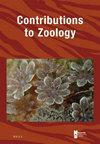New Miocene fossil taxa illuminate the evolution and paleobiogeography of the Ponto-Caspian gammaroid amphipod radiation
IF 2.1
2区 生物学
Q1 ZOOLOGY
引用次数: 0
Abstract
The Ponto-Caspian radiation of gammaroid amphipods is one of the world’s most diverse lacustrine crustacean radiations as well as the only lacustrine amphipod radiation with a fossil record (dating back 9 Ma). However, the phyletic relationship between fossils and extant species was never formally investigated, hampering our evolutionary understanding of this diverse clade. Here, we present the first morphology-based phylogeny (114 characters) of Ponto-Caspian gammaroids that includes 99% of extant taxa, all previously known fossils, as well as newly discovered fossil specimens from the Late Miocene (10.5 Ma) of eastern Romania. Our phylogenetic and phenetic results strongly support the monophyly of all fossil taxa. However, despite its widespread Late Miocene distribution throughout the Paratethys Sea, this fossil clade left no modern descendants. Its exact phylogenetic position is ambiguous, although it is nested in the radiation’s crown group. Morphometric analyses further indicate that fossil species occupy a narrower and peripheral morphospace relative to extant taxa. Our results support the assignment of the newly discovered Romanian fossils to a new genus, Eogmelina gen. nov. with two new species Eogmelina moldavica gen. et sp. nov. and Eogmelina prisca gen. et sp. nov. Finally, our findings call for a fundamental systematic restructuring of Ponto-Caspian gammaroids at genus and family level.新的中新世化石类群揭示了庞托-里海伽马类片脚类动物辐射的演化和古生物地理格局
庞托-里海双足类辐射是世界上最多样化的湖沼甲壳类辐射之一,也是唯一有化石记录(可追溯到 9 Ma)的湖沼双足类辐射。然而,化石与现生物种之间的植物学关系从未被正式研究过,这阻碍了我们对这一多样化支系的进化理解。在这里,我们首次提出了基于形态学(114 个特征)的庞托-里海伽马动物系统发生,其中包括 99% 的现生类群、以前已知的所有化石以及罗马尼亚东部晚中新世(10.5 Ma)新发现的化石标本。我们的系统发育和表型结果有力地支持了所有化石类群的单系性。然而,尽管该化石支系在整个帕拉泰西海广泛分布于晚中新世,却没有留下任何现代后裔。它在系统发育上的确切位置并不明确,尽管它嵌套在辐射的冠群中。形态分析进一步表明,与现生类群相比,化石物种占据了一个较窄的边缘形态空间。我们的研究结果支持将新发现的罗马尼亚化石归入一个新属--Eogmelina gen.最后,我们的发现要求在属和科的层面上对庞托-里海伽马拉类进行根本性的系统重构。
本文章由计算机程序翻译,如有差异,请以英文原文为准。
求助全文
约1分钟内获得全文
求助全文
来源期刊

Contributions to Zoology
生物-动物学
CiteScore
4.00
自引率
4.50%
发文量
16
审稿时长
>12 weeks
期刊介绍:
Contributions to Zoology solicits high-quality papers in all systematics-related branches of comparative zoology (including paleozoology). Preference will be given to manuscripts dealing with conceptual issues and to integrative papers (e.g., ecology and biodiversity, morphology and phylogeny and character state evolution, phylogeny and historical biogeography, systematics and bioinformatics, bioinformatics and biodiversity, habitat disturbance and biogeography, etc.). Reviews and alpha-taxonomic contributions are considered for publication, but acceptance will depend on their high quality and exceptional nature.
 求助内容:
求助内容: 应助结果提醒方式:
应助结果提醒方式:


